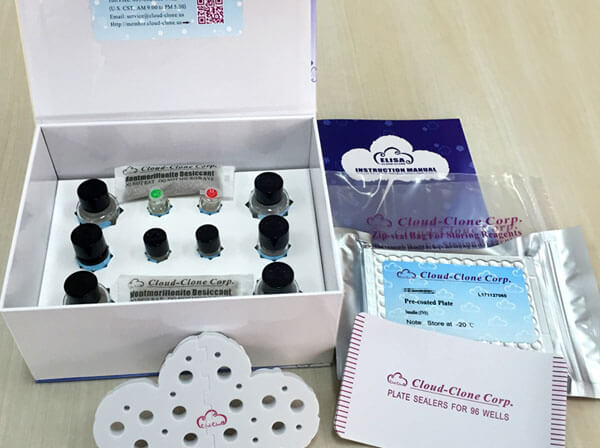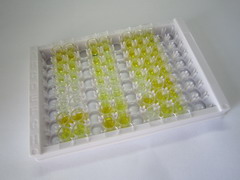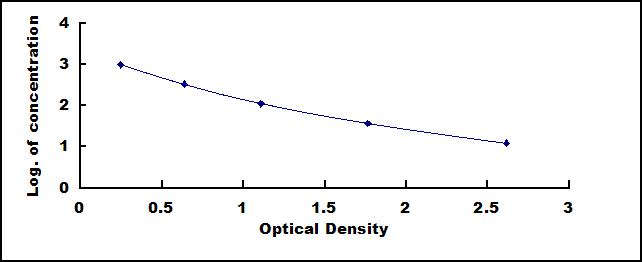ELISA Kit for Growth Hormone Releasing Hormone (GHRH) 

GRF; GHRF; Somatocrinin; Growth-Hormone-Releasing Factor; Sermorelin; Somatoliberin
- UOM
- FOB US$ 441.00 US$ 630.00 US$ 2,835.00 US$ 5,355.00 US$ 44,100.00
- Quantity
Overview
Properties
- Product No.CEA438Hu
- Organism SpeciesHomo sapiens (Human) Same name, Different species.
- ApplicationsEnzyme-linked immunosorbent assay for Antigen Detection.
Research use only - DownloadInstruction Manual
- CategoryEndocrinologyHormone metabolism
Sign into your account
Share a new citation as an author
Upload your experimental result
Review

Contact us
Please fill in the blank.
Recovery
Matrices listed below were spiked with certain level of recombinant Growth Hormone Releasing Hormone (GHRH) and the recovery rates were calculated by comparing the measured value to the expected amount of Growth Hormone Releasing Hormone (GHRH) in samples.
| Matrix | Recovery range (%) | Average(%) |
| serum(n=5) | 96-103 | 101 |
| EDTA plasma(n=5) | 95-103 | 101 |
| heparin plasma(n=5) | 95-103 | 99 |
Precision
Intra-assay Precision (Precision within an assay): 3 samples with low, middle and high level Growth Hormone Releasing Hormone (GHRH) were tested 20 times on one plate, respectively.
Inter-assay Precision (Precision between assays): 3 samples with low, middle and high level Growth Hormone Releasing Hormone (GHRH) were tested on 3 different plates, 8 replicates in each plate.
CV(%) = SD/meanX100
Intra-Assay: CV<10%
Inter-Assay: CV<12%
Linearity
The linearity of the kit was assayed by testing samples spiked with appropriate concentration of Growth Hormone Releasing Hormone (GHRH) and their serial dilutions. The results were demonstrated by the percentage of calculated concentration to the expected.
| Sample | 1:2 | 1:4 | 1:8 | 1:16 |
| serum(n=5) | 96-103% | 86-101% | 83-101% | 82-95% |
| EDTA plasma(n=5) | 95-103% | 87-102% | 80-88% | 93-101% |
| heparin plasma(n=5) | 84-93% | 98-105% | 78-103% | 96-103% |
Stability
The stability of kit is determined by the loss rate of activity. The loss rate of this kit is less than 5% within the expiration date under appropriate storage condition.
To minimize extra influence on the performance, operation procedures and lab conditions, especially room temperature, air humidity, incubator temperature should be strictly controlled. It is also strongly suggested that the whole assay is performed by the same operator from the beginning to the end.
Reagents and materials provided
| Reagents | Quantity | Reagents | Quantity |
| Pre-coated, ready to use 96-well strip plate | 1 | Plate sealer for 96 wells | 4 |
| Standard | 2 | Standard Diluent | 1×20mL |
| Detection Reagent A | 1 | Assay Diluent A | 1×12mL |
| Detection Reagent B | 1×120µL | Assay Diluent B | 1×12mL |
| Reagent Diluent | 1×300µL | Stop Solution | 1×6mL |
| TMB Substrate | 1×9mL | Instruction manual | 1 |
| Wash Buffer (30 × concentrate) | 1×20mL |
Assay procedure summary
1. Prepare all reagents, samples and standards;
2. Add 50µL standard or sample to each well.
And then add 50µL prepared Detection Reagent A immediately.
Shake and mix. Incubate 1 hour at 37°C;
3. Aspirate and wash 3 times;
4. Add 100µL prepared Detection Reagent B. Incubate 30 minutes at 37°C;
5. Aspirate and wash 5 times;
6. Add 90µL Substrate Solution. Incubate 10-20 minutes at 37°C;
7. Add 50µL Stop Solution. Read at 450 nm immediately.

Test principle
This assay employs the competitive inhibition enzyme immunoassay technique. A monoclonal antibody specific to Growth Hormone Releasing Hormone (GHRH) has been pre-coated onto a microplate. A competitive inhibition reaction is launched between biotin labeled Growth Hormone Releasing Hormone (GHRH) and unlabeled Growth Hormone Releasing Hormone (GHRH) (Standards or samples) with the pre-coated antibody specific to Growth Hormone Releasing Hormone (GHRH). After incubation the unbound conjugate is washed off. Next, avidin conjugated to Horseradish Peroxidase (HRP) is added to each microplate well and incubated. The amount of bound HRP conjugate is reverse proportional to the concentration of Growth Hormone Releasing Hormone (GHRH) in the sample. After addition of the substrate solution, the intensity of color developed is reverse proportional to the concentration of Growth Hormone Releasing Hormone (GHRH) in the sample.
Giveaways
Increment services
Citations
- Role of GHRH in Sleep and Growth Impairments Induced by Upper Airway Obstruction in RatsErs: 00197610
- Role of growth hormone-releasing hormone in sleep and growth impairments induced by upper airway obstruction in ratsPubMed: 21406516
- Effect of Moringa Oleifera Extract on Nicotine Induced Neurotoxicity in Female Rat and Their EmbryosIdosi: Source
- Zika Virus Infection in Hypothalamus Causes Hormone Deficiencies and Leads to Irreversible Growth Delay and Memory Impairment in MicePubmed: 30404008
- An Immuno‐PCR screen for the detection of CJC‐1295 and other Growth Hormone Releasing Hormone analogues in equine plasmaPubmed: 30489688
- Effects of somatotropic axis on cognitive dysfunction of obstructive sleep apneaPubmed: 31073904
- Lack of brain insulin receptor substrate-1 causes growth retardation, with decreased expression of growth hormone-releasing hormone in the hypothalamus.33980693
- Associations between serum levels of brain-derived neurotrophic factor, corticotropin releasing hormone and mental distress in vitiligo patientsPubmed:35508633

















